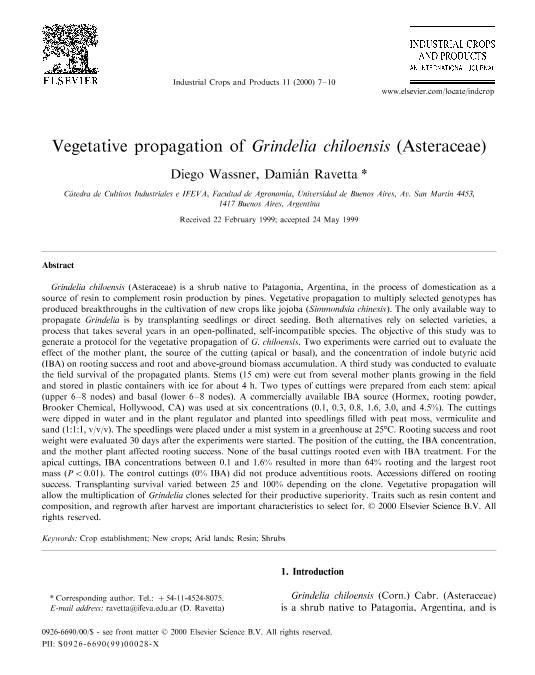Artículo
Vegetative propagation of Grindelia chiloensis (Asteraceae)
Fecha de publicación:
01/2000
Editorial:
Elsevier Science
Revista:
Industrial Crops and Products
ISSN:
0926-6690
Idioma:
Inglés
Tipo de recurso:
Artículo publicado
Clasificación temática:
Resumen
Grindelia chiloensis (Asteraceae) is a shrub native to Patagonia, Argentina, in the process of domestication as a source of resin to complement rosin production by pines. Vegetative propagation to multiply selected genotypes has produced breakthroughs in the cultivation of new crops like jojoba (Simmondsia chinesis). The only available way to propagate Grindelia is by transplanting seedlings or direct seeding. Both alternatives rely on selected varieties, a process that takes several years in an open-pollinated, self-incompatible species. The objective of this study was to generate a protocol for the vegetative propagation of G. chiloensis. Two experiments were carried out to evaluate the effect of the mother plant, the source of the cutting (apical or basal), and the concentration of indole butyric acid (IBA) on rooting success and root and above-ground biomass accumulation. A third study was conducted to evaluate the field survival of the propagated plants. Stems (15 cm) were cut from several mother plants growing in the field and stored in plastic containers with ice for about 4 h. Two types of cuttings were prepared from each stem: apical (upper 6-8 nodes) and basal (lower 6-8 nodes). A commercially available IBA source (Hormex, rooting powder, Brooker Chemical, Hollywood, CA) was used at six concentrations (0.1, 0.3, 0.8, 1.6, 3.0, and 4.5%). The cuttings were dipped in water and in the plant regulator and planted into speedlings filled with peat moss, vermiculite and sand (1:1:1, v/v/v). The speedlings were placed under a mist system in a greenhouse at 25°C. Rooting success and root weight were evaluated 30 days after the experiments were started. The position of the cutting, the IBA concentration, and the mother plant affected rooting success. None of the basal cuttings rooted even with IBA treatment. For the apical cuttings, IBA concentrations between 0.1 and 1.6% resulted in more than 64% rooting and the largest root mass (P<0.01). The control cuttings (0% IBA) did not produce adventitious roots. Accessions differed on rooting success. Transplanting survival varied between 25 and 100% depending on the clone. Vegetative propagation will allow the multiplication of Grindelia clones selected for their productive superiority. Traits such as resin content and composition, and regrowth after harvest are important characteristics to select for.
Palabras clave:
Establecimiento del Cultivo
,
Zonas Áridas
,
Arbustos
,
Resina
Archivos asociados
Licencia
Identificadores
Colecciones
Articulos(IFEVA)
Articulos de INST.D/INV.FISIOLOGICAS Y ECO.VINCULADAS A L/AGRIC
Articulos de INST.D/INV.FISIOLOGICAS Y ECO.VINCULADAS A L/AGRIC
Articulos(SEDE CENTRAL)
Articulos de SEDE CENTRAL
Articulos de SEDE CENTRAL
Citación
Wassner, Diego Fernan; Ravetta, Damián Andrés; Vegetative propagation of Grindelia chiloensis (Asteraceae); Elsevier Science; Industrial Crops and Products; 11; 1; 1-2000; 7-10
Compartir
Altmétricas




